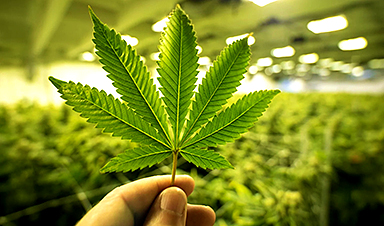Researchers at the Comprehensive Center for Pain & Addiction conducted tests on five terpenes, finding promising results in their pain-relief capabilities.
A study from the University of Arizona Health Sciences, published in the journal PAIN, discovered that terpenes from Cannabis sativa were as effective as morphine in alleviating chronic neuropathic pain. Additionally, combining these two analgesics improved pain relief without negative side effects.
Some prior studies have shown that the Cannabis sativa plant and its two primary cannabinoids, tetrahydrocannabinol, or THC, and cannabidiol, or CBD, can be effective in managing chronic pain; however, the effects are generally moderate and can come with unwanted psychoactive side effects. Terpenes, the compounds that give plants their aroma and taste, offer an alternative path to pain relief without adverse side effects.
“A question that we’ve been very interested in is could terpenes be used to manage chronic pain?” said lead researcher John Streicher, PhD, a member of the Comprehensive Center for Pain & Addiction and a professor of pharmacology at the College of Medicine – Tucson. “What we found is that terpenes are really good at relieving a specific type of chronic pain with side effects that are low and manageable.”
John Streicher, PhD, is a member of the University of Arizona Health Sciences Comprehensive Center for Pain & Addiction and a professor of pharmacology at the College of Medicine – Tucson. Credit: Noelle Haro-Gomez, University of Arizona Health Sciences
Research on Terpenes
Terpenes are found in all plants, and most plants have two dominant terpene species. Cannabis is unique in that it contains up to 150 terpenes with multiple terpenes acting as the dominant species. Streicher and the research team tested five terpenes that are found in moderate to high levels in Cannabis: alpha-humulene, beta-caryophyllene, beta-pinene, geraniol, and linalool.
In a prior study, Streicher’s team found that four of those terpenes mimicked the effects of cannabinoids, including a reduction in the sensation of pain, in animal models of acute pain. For this study, they used a mouse model of chemotherapy-induced neuropathic pain, a type of chronic pain that occurs when highly toxic chemotherapy medications cause nerve damage that results in pain.
Cannabis sativa is unique in that it contains up to 150 terpenes with multiple terpenes acting as the dominant species. Credit: Noelle Haro-Gomez, University of Arizona Health Sciences
The terpenes were tested individually and compared with morphine. The research team found that each terpene was successful in reducing the sensation of pain at levels near to or above the peak effect of morphine. When the terpenes were combined with morphine, the pain-relieving effects of all five terpene/morphine combinations were significantly increased.
“That was really striking to us, but just because something relieves pain doesn’t necessarily mean it’s going to be a good therapy,” Streicher said.
Comparing Terpenes and Opioids
Opioids are often used to treat many types of pain, but they can come with a host of unwanted side effects. Opioids activate the brain’s reward system, which is what can lead to addiction, and can cause tolerance, a condition that occurs when the body gets used to a medication and needs increasingly larger doses to have the same effect. Opioids also can cause respiratory depression, which can lead to death.
“We looked at other aspects of the terpenes, such as: Does this cause reward? Is this going to be addictive? Is it going to make you feel awful?” Streicher said. “What we found was yes, terpenes do relieve pain, and they also have a pretty good side effect profile.”
None of the terpenes had reward liability, making them a low risk for addiction. Some of the terpenes also did not cause aversive behaviors, which suggests they could be effective therapeutics without producing distressing side effects.
Finally, researchers tested different routes of terpene administration: injection, oral dosing, and inhalation of vaporized pure terpenes. They found that when terpenes were given orally or inhaled, the effects were significantly reduced or absent.
“A lot of people vape or smoke terpenes as part of cannabis extracts that are available commercially in states where cannabis use is legal,” Streicher said “We were surprised to find that the inhalation route didn’t have an impact in this study, because there are a lot of at least anecdotal reports saying that you can get the effects of terpenes whether taken orally or inhaled. Part of the confounding factor is that terpenes smell quite nice and it’s hard to disguise that aroma, so people could be kind of having the psychosomatic placebo-style effect.”
Because this is the first paper to examine the side effects of terpenes, Streicher will be using its findings to inform the next stage of research – can terpenes block the reward potential of an opiate such as morphine while at the same time enhancing its pain-relief potential?
“This brings up the idea that you could have a combination therapy, an opioid with a high level of terpene, that could actually make the pain relief better while blocking the addiction potential of opioids,” Streicher said. “That’s what we are looking at now.”
Reference: “Terpenes from Cannabis sativa induce antinociception in a mouse model of chronic neuropathic pain via activation of adenosine A2A receptors” by Abigail M. Schwarz, Attila A. Keresztes, Thai A. Bui, Ryan A. Hecksel, Adriana Peña, Brianna A. Lent, Zhan-Guo Gao, Martín A. Gamez-Rivera, Caleb A. Seekins, Kerry A. Chou, Taylor L. Appel, Kenneth A. Jacobson, Fahad A. Al-Obeidi and John M. Streicher, 2 May 2024, PAIN.
DOI: 10.1097/j.pain.0000000000003265
The study was funded by the National Institutes of Health and the National Institute of Diabetes and Digestive and Kidney Diseases.
News
Melting Arctic Ice May Unleash Ancient Deadly Diseases, Scientists Warn
Melting Arctic ice increases human and animal interactions, raising the risk of infectious disease spread. Researchers urge early intervention and surveillance. Climate change is opening new pathways for the spread of infectious diseases such [...]
Scientists May Have Found a Secret Weapon To Stop Pancreatic Cancer Before It Starts
Researchers at Cold Spring Harbor Laboratory have found that blocking the FGFR2 and EGFR genes can stop early-stage pancreatic cancer from progressing, offering a promising path toward prevention. Pancreatic cancer is expected to become [...]
Breakthrough Drug Restores Vision: Researchers Successfully Reverse Retinal Damage
Blocking the PROX1 protein allowed KAIST researchers to regenerate damaged retinas and restore vision in mice. Vision is one of the most important human senses, yet more than 300 million people around the world are at [...]
Differentiating cancerous and healthy cells through motion analysis
Researchers from Tokyo Metropolitan University have found that the motion of unlabeled cells can be used to tell whether they are cancerous or healthy. They observed malignant fibrosarcoma cells and [...]
This Tiny Cellular Gate Could Be the Key to Curing Cancer – And Regrowing Hair
After more than five decades of mystery, scientists have finally unveiled the detailed structure and function of a long-theorized molecular machine in our mitochondria — the mitochondrial pyruvate carrier. This microscopic gatekeeper controls how [...]
Unlocking Vision’s Secrets: Researchers Reveal 3D Structure of Key Eye Protein
Researchers have uncovered the 3D structure of RBP3, a key protein in vision, revealing how it transports retinoids and fatty acids and how its dysfunction may lead to retinal diseases. Proteins play a critical [...]
5 Key Facts About Nanoplastics and How They Affect the Human Body
Nanoplastics are typically defined as plastic particles smaller than 1000 nanometers. These particles are increasingly being detected in human tissues: they can bypass biological barriers, accumulate in organs, and may influence health in ways [...]
Measles Is Back: Doctors Warn of Dangerous Surge Across the U.S.
Parents are encouraged to contact their pediatrician if their child has been exposed to measles or is showing symptoms. Pediatric infectious disease experts are emphasizing the critical importance of measles vaccination, as the highly [...]
AI at the Speed of Light: How Silicon Photonics Are Reinventing Hardware
A cutting-edge AI acceleration platform powered by light rather than electricity could revolutionize how AI is trained and deployed. Using photonic integrated circuits made from advanced III-V semiconductors, researchers have developed a system that vastly [...]
A Grain of Brain, 523 Million Synapses, Most Complicated Neuroscience Experiment Ever Attempted
A team of over 150 scientists has achieved what once seemed impossible: a complete wiring and activity map of a tiny section of a mammalian brain. This feat, part of the MICrONS Project, rivals [...]
The Secret “Radar” Bacteria Use To Outsmart Their Enemies
A chemical radar allows bacteria to sense and eliminate predators. Investigating how microorganisms communicate deepens our understanding of the complex ecological interactions that shape our environment is an area of key focus for the [...]
Psychologists explore ethical issues associated with human-AI relationships
It's becoming increasingly commonplace for people to develop intimate, long-term relationships with artificial intelligence (AI) technologies. At their extreme, people have "married" their AI companions in non-legally binding ceremonies, and at least two people [...]
When You Lose Weight, Where Does It Actually Go?
Most health professionals lack a clear understanding of how body fat is lost, often subscribing to misconceptions like fat converting to energy or muscle. The truth is, fat is actually broken down into carbon [...]
How Everyday Plastics Quietly Turn Into DNA-Damaging Nanoparticles
The same unique structure that makes plastic so versatile also makes it susceptible to breaking down into harmful micro- and nanoscale particles. The world is saturated with trillions of microscopic and nanoscopic plastic particles, some smaller [...]
AI Outperforms Physicians in Real-World Urgent Care Decisions, Study Finds
The study, conducted at the virtual urgent care clinic Cedars-Sinai Connect in LA, compared recommendations given in about 500 visits of adult patients with relatively common symptoms – respiratory, urinary, eye, vaginal and dental. [...]
Challenging the Big Bang: A Multi-Singularity Origin for the Universe
In a study published in the journal Classical and Quantum Gravity, Dr. Richard Lieu, a physics professor at The University of Alabama in Huntsville (UAH), which is a part of The University of Alabama System, suggests that [...]























